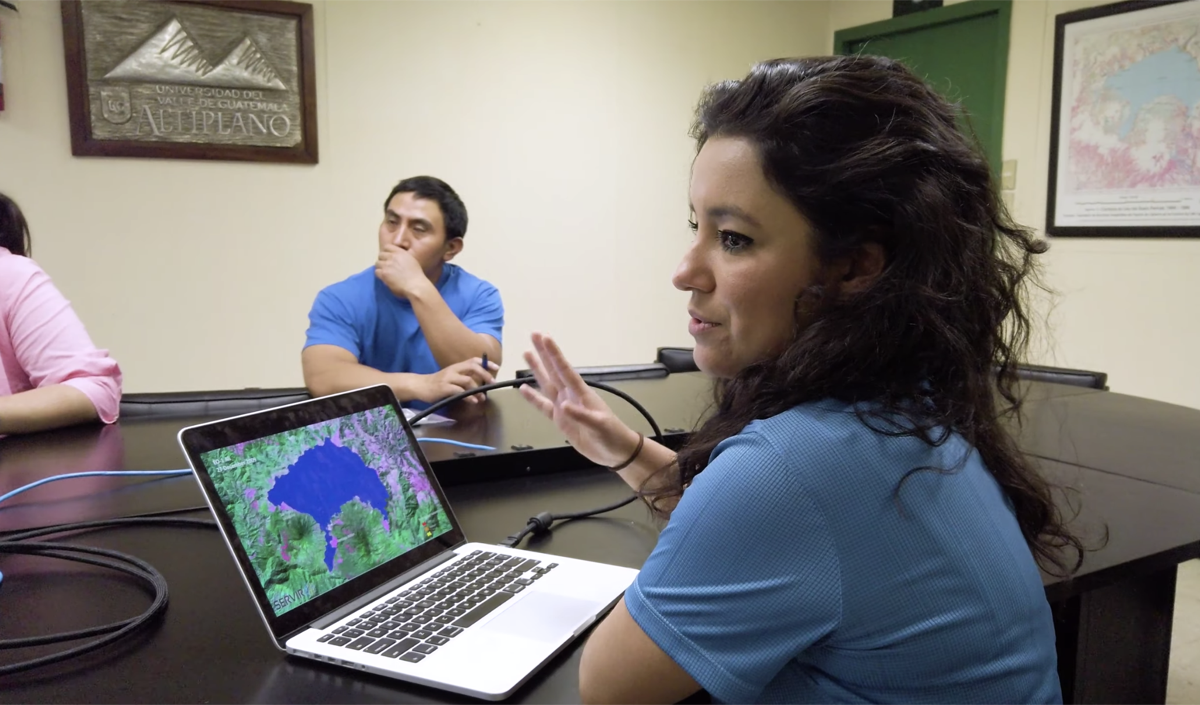This video is a part of Breakthrough, a short film anthology from Science Friday and Howard Hughes Medical Institute (HHMI) that follows women working at the forefront of their fields. Learn more and watch the films on our Breakthrough spotlight.
Growing up in rural Guatemala, Africa Flores-Anderson was used to seeing unregulated agricultural runoff and polluted waterways. She thought that all landscapes in her country were laden with contaminated waters. When she went to live in western Guatemala where the land is less farmed, she saw for the first time healthy rivers, lakes, and forests. It was the moment Flores-Anderson decided to dedicate her life and education to environmental sciences and sustainability. To help underserved communities like the one she grew up in, Flores-Anderson focused her studies on learning how to collect and interpret satellite data across huge landscapes and waterways

“From space, I can see the forest and the condition of that forest, and I can see the river and the water quality of that river,” she says. “It completely revolutionized my world of the work I was doing.”
Today, she works as an earth scientist and regional coordinator for the SERVIR (a collaborative NASA and USAID project), where she models environmental changes in regions without science infrastructure and resources. Her work helps decision-makers visualize fire, industrial, or disaster damage, predict future risks, and influence the allocation of development funds. In addition to this work, Flores-Anderson acquired funding to monitor the water quality of Guatemala’s Lake Atitlán, a source of drinking water, fishing, irrigation, and tourism.
Lake Atitlán is known for its pristine waters, but Flores-Anderson has been monitoring recurring harmful algal blooms. Using her GIS skills, Flores-Anderson is mapping the levels of cyanobacteria in the lake over time and finding correlations with agricultural activity on the lake’s banks. With these advanced tools, she wants to identify the severity of the problem and pass insights on to local authorities to allow them to save Atitlán from the fate of the degraded landscapes of her youth.
Further Reading
- Learn more about SERVIR.
Donate To Science Friday
Invest in quality science journalism by making a donation to Science Friday.
Credits
Directed and Produced by Katie Garrett
Director of Photography – Katie Garrett and Michelle Lotker
Edited by Erika Sutter and Katie Garrett
Animations by Luke Groskin
Satellite Data Provided by Africa Flores Anderson
Music by Audio Network On-Location
Production Support Rudy Augusto Flores Cano
Series Producer Luke Groskin Landsat4, 5, 6, 7, and 8 Images Courtesy of the U.S. Geological Survey Copernicus Sentinel 1 and 2 Images Processed by the European Space Agency.
Additional Satellite Images by SeaWiFS Project, NASA/Goddard Space Flight Center, and ORBIMAGE Matthew R. Radcliff, James R. Irons, Cindy Starr, Rachel Kreutzinger NASA Earth Observatory image by Jesse Allen, Level 1 and Atmospheres Active Distribution System (LAADS)
Additional Photos and Video Provided by Shutterstock
Project Advisors for HHMI Tangled Bank Studios Richard Stone Aileen O’Hearn
Project Support for Science Friday Initiative Danielle Dana, Jennifer Fenwick, Ariel Zych Nadja Oertelt, Kyle Marian Viterbo, Diana Montano Daniel Peterschmidt, Xochitl Garcia, Nahima Ahmed
Special Thanks Rudy A. Flores Cano · Rudy A. Flores Cordova Eva de la Luz Cordova Sanchez de Flores Claudia Suseth Romero Oliva · Margaret Dix Jorge Jose Garcia · Molly Porter Universidad del Valle de Guatemala Universidad de San Carlos University of Alabama in Huntsville NASA-Marshall Space Flight Center
Related Links
 A selection of Science Friday’s podcasts, teaching guides, and other resources are available in the LabXchange library, a free global science classroom open to every curious mind.
A selection of Science Friday’s podcasts, teaching guides, and other resources are available in the LabXchange library, a free global science classroom open to every curious mind.
Meet the Producers and Host
About Katie Garrett
@katieggarrettKatie Garrett is a filmmaker, biologist, photographer, and artist. She has produced film pieces for National Geographic, Geographical Magazine (Royal Geographical Society), bioGraphic (California Academy of Sciences), Ensia, and Operation Wallacea.
About Luke Groskin
@lgroskinLuke Groskin is Science Friday’s video producer. He’s on a mission to make you love spiders and other odd creatures.